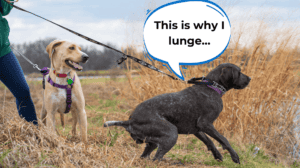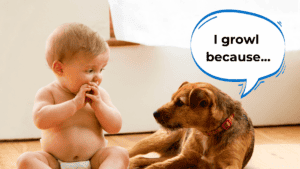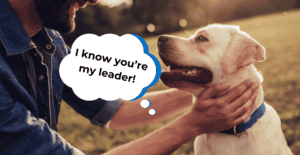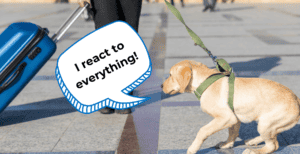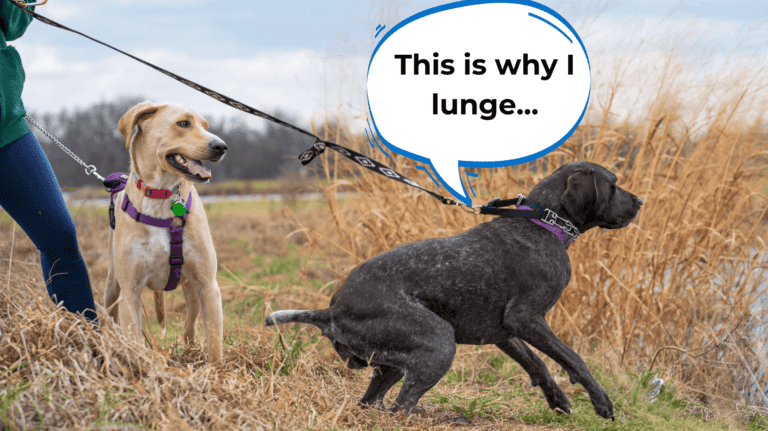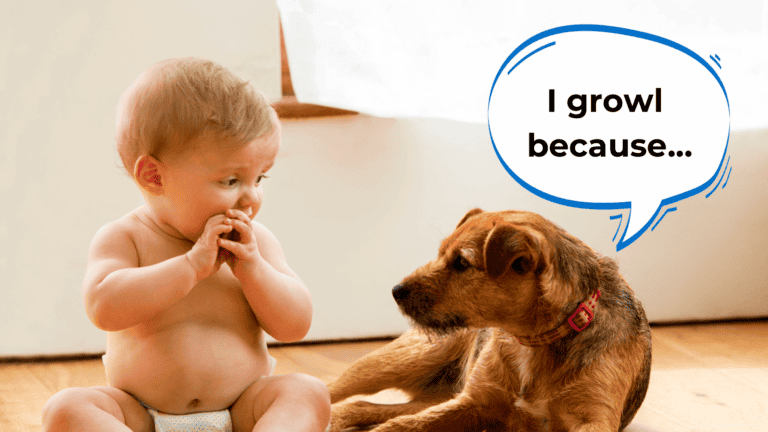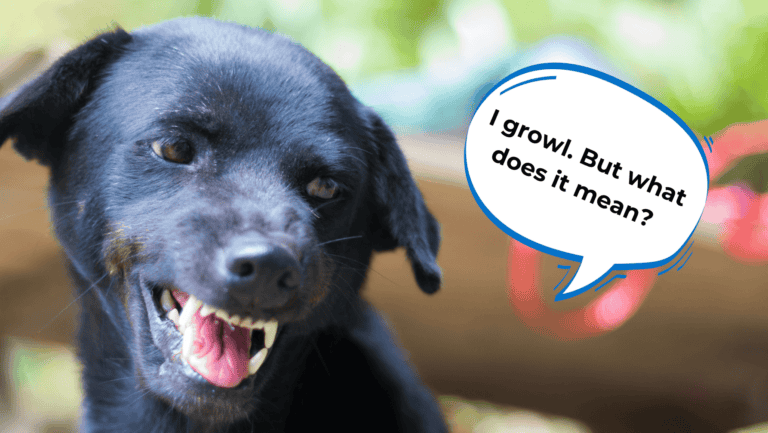When you deal with a fear biter, you have to understand that this dog’s tendency to bite is not fueled by the desire to simply bite.
These fear biters are fierce protectors.
When dog owners come to me and ask about aggression due to fear, I tell them when they deal with a fear biter, they have to halt the training until they solve the problem on a deeper level.

Because most of the time, fear-based aggression that causes biting is not a matter of lack of training but a lack of tactic.
In this blog, I’m going to talk about the number one reason why dogs bite due to fear, and how you — their dog owner — can actually change fear biters.
Key Takeaways
- Fear biters don’t bite out of habit. They use biting as a way to protect you and the property from danger.
- The number one reason why fear biters continue to bite is because they feel that they are in charge, so they have to do all the protecting.
- The Dog Calming Code teaches the 5 Golden Rules, a set of rules that can help establish YOUR leadership in your fearful dog’s eyes.
JOIN MY FREE REACTIVITY CLASS
Table of Contents
- How to Deal with a Fear Biter: The #1 Reason a Fear Biter Bites
- How to Deal With a Fear Biter: Change Dog Biting Aggression By Being the Pack Leader
- So… How Do You Become the Pack Leader That Stops Fear Biting Aggression?
- How to Deal with a Fear Biter: How Being a Pack Leader Changes Biting Due to Fear Aggression
- How to Deal With Biting Due to Fear Aggression: Other Reasons Why Dogs Become Fear Biters
- Fear Biting Dogs: What Are The Signs to Look Out For?
- How to Change the Fear Biting Aggression in Dogs
- How to Deal with a Fear Biter: Let the Dog Calming Code Help You!
How to Deal with a Fear Biter: The #1 Reason a Fear Biter Bites
So why do fearful dogs bite?
Like what I always mention in my previous blogs, dogs fueled by fear are driven by their primal responsibility to protect.
This issue puzzles dog owners: they usually have a pretty well-mannered dog, until a perceived danger or threat comes near.
They immediately show their fangs, and they don’t hesitate biting anything or anyone who they think disrupts safety.
I want to emphasize again: fear biters don’t just bite out of habit — they perceive themselves as the one in charge of their owners and their property so… they bite to protect.

Here’s a scenario that can explain it better.
As parents, we’re actually pretty chill when we’re alone. It’s a different story when we have kids that are under our care.
We become more wary about things around us — even anxious! — and always on the edge to protect our kids from the danger of strangers and threatening circumstances.
Why? Because we know that when it comes to our kids, we are the ones in charge.

And it’s the same with our dogs.
Of course they will be scared. Of course they will be protective!
LEARN THE DOG CALMING CODE (FOR FREE)
The fearful biter is a dog that sees themselves as the pack leader and they want the source of danger to know that. They bite to make the danger stay away.
So how do you let the fear biter know that there’s nothing they should be worried — or biting — about?
How to Deal With a Fear Biter: Change Dog Biting Aggression By Being the Pack Leader
Dealing with a fear biter requires both understanding and proactive steps. Becoming the pack leader is a powerful way to effectively address your dog's fear aggression.
Here's a detailed guide on how to do it:
Our Dogs Have to Know That They Are Not the Leader, It’s Us
Dogs often have a natural tendency to assume leadership, which can lead to constant anxiety, vigilance, and eventually fear-based aggression.
The best remedy is to assert ourselves as the leaders. Here's how:
#1: Stay Calm in the Face of Danger
Dogs pick up on our reactions.
When they sense danger, try to remain composed.

Even if their barking or biting tendencies can get into you, demonstrate that you are unfazed.
Let them see that you acknowledge the situation but are not troubled by it. This reassures them that there's nothing to worry about because YOU will do all the worrying.
#2: Use Calm and Consistent Corrections
If your dog continues to exhibit anxious or aggressive behavior despite your calm leadership, use calm and consistent corrections, such as timeouts.
Over time, this can help reinforce your position as the pack leader and correct any bad behavior before it becomes extreme.
FREE REACTIVITY MASTERCLASS
Dogs Should Know They Can Transfer Leadership to Us for Peace of Mind
A dog’s primal desire to protect is really strong.

So even if you tell them “Don’t worry about it!” they will still worry about it, especially if they don’t see you as the leader who can actually handle dangerous business.
Dogs Should Know You Deal with Danger, Strangers, and Strange Noises Confidently
As the pack leader, you have the responsibility to handle potential threats, whether they be danger, strangers, or unfamiliar sounds or objects.
Your confidence in dealing with these situations conveys to your dog that they are safe under your care.
By showcasing your ability to take charge and face challenges with confidence, your dog gains a sense of security. They recognize that you are there to protect them, reducing their need to resort to fear-based aggression.
So… How Do You Become the Pack Leader That Stops Fear Biting Aggression?
After years of working with thousands of dogs as a top-notch dog trainer, I've got the lowdown on how to be the kind of pack leader your dogs can really rely on.

And guess what? I'm spilling the beans in the Dog Calming Code™️, an online dog training program that spills all the secrets of the 5 Golden Rules of dog leadership.
In the Dog Calming Code, you'll uncover everything you need to know about stepping up as the pack leader, earning your dog's trust, and helping them overcome their tendency to bite out of fear!
You can learn more about the Dog Calming Code here.
How to Deal with a Fear Biter: How Being a Pack Leader Changes Biting Due to Fear Aggression
Now if they start to see you as a pack leader, your call to build confidence instead of fear BECOMES BIGGER.
Here’s a quick analogy:
Imagine there’s an ice cream truck in the middle of the woods.
This ice cream truck is a strange, very random sight to the wolves in there.

How will the rest of the pack react to this foreign thing? Totally depends on the pack leader!
GET MY 5 GOLDEN RULES FOR FREE!
If the pack leader or the alpha panics after seeing the ice cream truck, guess what will happen? The rest of the pack will panic, too.
If the pack leader or the alpha pees all over the ice cream truck, the pack understands they have nothing to worry about it.
If the pack leader ignores the ice cream truck, you can bet a dollar that the rest of the pack will ignore it, too.
However the pack leader reacts, the rest of the pack follows.
How to Deal With Biting Due to Fear Aggression: Other Reasons Why Dogs Become Fear Biters
Reason #1: When Dogs Deal with a New Environment
Dogs can exhibit fear aggression when introduced to new environments.
They may feel overwhelmed or anxious in unfamiliar surroundings, leading to defensive behavior, including biting.

When you do have to introduce a new environment to your beloved dogs, please do so gradually. A gradual introduction provides positive experiences and reassurance to ease their anxiety.
When You Introduce New Routines
Is the change of season calling you to change routines as well? Well, you might soon deal with an anxious fear biter.
A sudden disruption in their daily schedule creates stress and uncertainty. Just like navigating around new environments, try introducing routine changes one at a time.
REVERSE REACTIVITY (FREE WEB CLASS)
When Dogs Meet New Animals
If your dog has dealt with scary past experiences with other animals, introducing them to a new pet can spell trouble.

Fearful dogs may react aggressively when confronted with unfamiliar animals as a defense mechanism.
Careful and controlled introductions to other animals, under supervision, can help reduce fear-based aggression.
When Dogs Deal with Stranger Danger
The most common fear biting trigger in dogs is stranger danger.
When dogs perceive a person as a threat, they may resort to aggression as a way to protect themselves or their owners. When a sound or an object looks strange enough to simply be ignored, your dog will be on high alert.

The solution to a fear biter’s problem with stranger danger? Socialization and consistency in showing your dogs YOU take care of danger! These are key to helping dogs become more comfortable around strangers.
Gradual exposure to new people, along with positive reinforcement, can help them overcome this fear.
REACTIVITY SOLVED (NO FOOD, NO FORCE)
Fear Biting Dogs: What Are The Signs to Look Out For?
Sign #1: Immediate Aggression to Strangers
Immediate aggression towards strangers is a clear sign of fear-based aggression in dogs.
When they perceive someone they don't know as a threat, they may react defensively by growling, barking, or even biting.
This response is their way of trying to protect themselves or their owners from what they perceive as a potential danger.
Sign #2: Reactive to Strange Noises, Sounds, Environment
Dogs with fear-based aggression can be highly reactive to unusual noises, sounds, or changes in their environment.

Dogs may bark, growl, or even attack when they feel threatened or startled.
Sign #3: Growling
Growling is a common warning sign that a dog is feeling fearful or threatened. It's their way of communicating their discomfort or distress.
When a dog growls, it's essential to pay attention and address the underlying cause of their fear.
Ignoring this warning sign can lead to more severe aggression if the fear is not addressed.
JOIN MY FREE REACTIVITY CLASS
Sign #4: Prancing Towards Someone or Something

It's often a display of their readiness to react to a perceived threat. This behavior is typically seen when a dog is on high alert and may precede more aggressive actions if the threat continues.
Sign #5: Raised Tail
A raised tail can indicate fear or anxiety in dogs. While some dogs may raise their tails as a sign of confidence, in fearful dogs, a raised tail is often a defensive posture.
It can be accompanied by other signs of tension, such as stiff body language or growling.

Sign #6: Perked Ears
Perked ears are another sign of heightened alertness in dogs.
When a dog's ears are pricked forward and rigid, it indicates that they are paying close attention to their surroundings, possibly due to fear or uncertainty.
This is a way for them to gather as much information as possible about potential threats.
Sign #7: Bared Teeth
Baring teeth is a more overt sign of aggression and fear. When a dog shows their teeth, it's a clear signal that they are feeling threatened or defensive.
It's often a precursor to biting and should be taken seriously. Dogs displaying this behavior should be approached cautiously and with care.
LEARN THE DOG CALMING CODE (FOR FREE)
Sign #8: Body Stiffness
A stiff or rigid body posture is a common indication of fear and anxiety in dogs.
When a dog's body becomes tense and immobile, it's a sign that they are on high alert and ready to react defensively.
Stiffness can be seen in conjunction with other fear-related behaviors like growling or baring teeth.
How to Change the Fear Biting Aggression in Dogs
Tip #1: Be a Confident Leader Who Deals with Danger
As the pack leader, you must exhibit confidence in dealing with potential dangers.
Dogs look to you for guidance, and your calm and composed demeanor can reassure them that you have the situation under control.
Confidence in your leadership helps reduce their anxiety and fear.
Tip #2: Watch Your Energy – Your Dog Feels It (If You’re Scared, They’ll be Scared, Too)
Dogs are highly attuned to their owners' emotions and energy. If you are fearful or anxious, your dog will pick up on those emotions and mirror them.

Maintaining a calm and confident energy is crucial when dealing with fear aggression, as your dog's reactions are often a reflection of your own state of mind.
Tip #3: Calm Dogs Down with a Safe Space
Providing your dog with a safe space they can retreat to is essential.
I usually tell dog owners to bring their dogs to a safe space once they sense fear aggression picking up.
FREE REACTIVITY MASTERCLASS
This safe haven should be exclusive to the anxious dogs, free of distractions and disturbance. A crate, a quiet room, or a space far from the triggers can help your dogs diffuse anxiety.
Tip #4: Introduce New Animals, Things, and Environments Slowly
Gradual exposure to new animals, objects, and environments is crucial for dogs prone to fear aggression.
Rushing introductions can heighten their anxiety and trigger defensive behavior. Take your time to introduce them to new stimuli at their own pace, using positive reinforcement to build their confidence.:

Tip #5: Understand and Be Familiar with Triggers
Identifying the specific triggers causing fear aggression in your dog is essential for effective management.
Keep a record of situations or stimuli that provoke their fearful reactions; this can help you avoid or mitigate these triggers in the future.
How to Deal with a Fear Biter: Let the Dog Calming Code Help You!
Just one look at a dog with a fear biting aggression, and one can say “This dog needs help!”
If you have a fear biter, the terrified look on their face whenever they have to toughen up to ward off danger can be too much.
The good news is that YOU can help.
I know it can be overwhelming because you have to do things right.
But with the Dog Calming Code, you don’t need to change your fear biter on your own.
My step-by-step guide in helping you establish leadership and letting your dog know:
- They’re not in charge can change your fearful dog into one who knows they’re not in charge of danger.
- They don’t need to bite just to protect us.
- They don’t have to bear the stress of keeping danger away.
If you want to learn more about how the Dog Calming Code can change your fear biter, click here.

~ Doggy Dan




